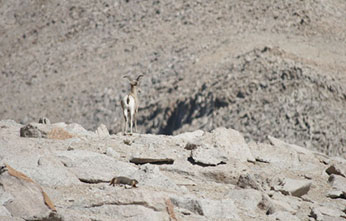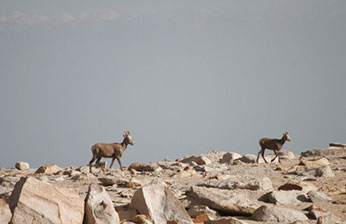Overview
 A ewe surveying the Cottonwood basin while a marmot looks on. Photo by Steve Bakos.
A ewe surveying the Cottonwood basin while a marmot looks on. Photo by Steve Bakos.
 A ewe and a lamb in the Wooley Back area, where forage is good, but sparse. Photo by Steve Bakos.
A ewe and a lamb in the Wooley Back area, where forage is good, but sparse. Photo by Steve Bakos.
The Mount Langley herd was initially reestablished in 1980 with the translocation of 10 Sierra bighorn from the Mt. Baxter herd. The herd was subsequently augmented with an additional 15 animals in the early 1980s. By 2016, Mt. Langley was one of the largest and most productive herds in the Sierra, at which time we estimated there were at least 90 Sierra bighorn there. Because of its great success, Langley was used as a source herd for translocations to the Cathedral Range, Mt. Gibbs, Olancha Peak, and Convict Creek in recent years.
In summer, bighorn in this herd are highly visible by hikers summiting Mt. Langley and hiking through Cottonwood Lakes Basin, over New Army Pass, and north to Soldier Meadows and the Miter Basin.
After tremendous losses of bighorn in this herd during the winter of 2016-2017 (~29+ animals known to have died in 1 year), the total population decreased dramatically and the herd is no longer being used as a source for translocations. We are now keeping a close eye on mortality rates in the herd. See Predation impedes recovery of Sierra Nevada bighorn sheep (PDF) for more information on the recent predation events at Mt. Langley.
Mount Langley Herd Movement Data
Events
- 10/20/24 We captured and collared 2 ewes and 2 rams in this herd.
- 9/21/2023 Several survey attempts this summer produced our lowest count in many years. We only saw about 10 ewes, 5 lambs, and 6 rams.
- 2/3/2023 A ewe that was previously believed dead was seen alive in a group of 13 above Tuttle Creek.
- 8/31/2022 We counted more ewes this summer than we have in recent years. Our survey count was 14 rams, 22 ewes, and 8 lambs.
- 8/13/2020 On this summer survey we accounted for only 17 ewes, 8 lambs, and 12 rams. This population is lower than it has been in 18 years.
- 8/21/2018 46 sheep were seen during the annual survey. This number is lower than in 2016 because of high mortality rates during the past winters.
- 5/15/2017 Over the course of the past year we documented 29 mortalities in this herd, a crushing loss to this once flourishing herd. 19 of these mortalities were due to mountain lion predation.
- 9/7/2016 The program staff saw 78 sheep in the annual Langley survey. It appears that the Langley herd unit is doing very well.
- 2/15/2016 S414, a lamb, moved from lower Diaz Creek to Joe Devil Peak. What a long journey for a lamb in the winter!